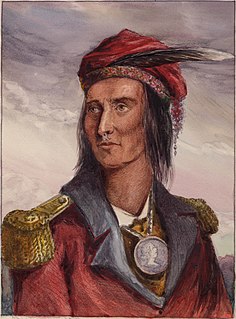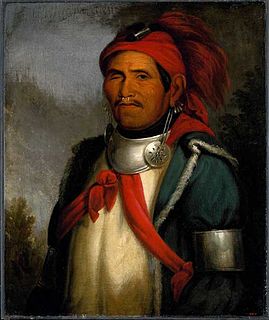Related Research Articles

The Black Hawk War was a conflict between the United States and Native Americans led by Black Hawk, a Sauk leader. The war erupted after Black Hawk and a group of Sauks, Meskwakis (Fox), and Kickapoos, known as the "British Band", crossed the Mississippi River, into the U.S. state of Illinois, from Iowa Indian Territory in April 1832. Black Hawk's motives were ambiguous, but he was apparently hoping to reclaim land sold to the United States in the disputed 1804 Treaty of St. Louis.

The Battle of Tippecanoe was fought on November 7, 1811, in Battle Ground, Indiana, between American forces led by then Governor William Henry Harrison of the Indiana Territory and Native American forces associated with Shawnee leader Tecumseh and his brother Tenskwatawa, leaders of a confederacy of various tribes who opposed European-American settlement of the American frontier. As tensions and violence increased, Governor Harrison marched with an army of about 1,000 men to attack the confederacy's headquarters at Prophetstown, near the confluence of the Tippecanoe River and the Wabash River.

The Miami are a Native American nation originally speaking one of the Algonquian languages. Among the peoples known as the Great Lakes tribes, they occupied territory that is now identified as North-central Indiana, southwest Michigan, and western Ohio. The Miami were historically made up of several prominent subgroups, including the Piankeshaw, Wea, Pepikokia, Kilatika, Mengakonkia, and Atchakangouen. In modern times, Miami is used more specifically to refer to the Atchakangouen. By 1846, most of the Miami had been forcefully displaced to Indian Territory. The Miami Tribe of Oklahoma are the federally recognized tribe of Miami Indians in the United States. The Miami Nation of Indiana, a nonprofit organization of descendants of Miamis who were exempted from removal, have unsuccessfully sought separate recognition.

Tecumseh was a Shawnee chief and warrior who promoted resistance to the expansion of the United States onto Native American lands. A persuasive orator, Tecumseh traveled widely, forming a Native American confederacy and promoting intertribal unity. Even though his efforts to unite Native Americans ended with his death in the War of 1812, he became an iconic folk hero in American, Indigenous, and Canadian popular history.

The Potawatomi, also spelled Pottawatomi and Pottawatomie, are a Native American people of the western Great Lakes region, upper Mississippi River and Great Plains. They traditionally speak the Potawatomi language, a member of the Algonquin family. The Potawatomi call themselves Neshnabé, a cognate of the word Anishinaabe. The Potawatomi are part of a long-term alliance, called the Council of Three Fires, with the Ojibway and Odawa (Ottawa). In the Council of Three Fires, the Potawatomi are considered the "youngest brother" and are referred to in this context as Bodwéwadmi, a name that means "keepers of the fire" and refers to the council fire of three peoples.

Tecumseh's War or Tecumseh's Rebellion was a conflict between the United States and Tecumseh's Confederacy, led by the Shawnee leader Tecumseh in the Indiana Territory. Although the war is often considered to have climaxed with William Henry Harrison's victory at the Battle of Tippecanoe in 1811, Tecumseh's War essentially continued into the War of 1812 and is frequently considered a part of that larger struggle. The war lasted for two more years, until 1813, when Tecumseh and his second-in-command, Roundhead, died fighting Harrison's Army of the Northwest at the Battle of the Thames in Upper Canada, near present-day Chatham, Ontario, and his confederacy disintegrated. Tecumseh's War is viewed by some academic historians as the final conflict of a longer-term military struggle for control of the Great Lakes region of North America, encompassing a number of wars over several generations, referred to as the Sixty Years' War.

The Shawnee are an Algonquian-speaking indigenous people of the Northeastern Woodlands. In the 17th century they lived in Pennsylvania, and in the 18th century they were in Pennsylvania, Ohio, and Indiana with some bands in Kentucky and Alabama. By the 19th century, they were forcibly removed to Missouri, Kansas, Texas, and ultimately Indian Territory, which became Oklahoma under the 1830 Indian Removal Act.

Tenskwatawa was a Native American religious and political leader of the Shawnee tribe, known as the Prophet or the Shawnee Prophet. He was a younger brother of Tecumseh, a leader of the Shawnee. In his early years Tenskwatawa was given the name Lalawethika, but he changed it around 1805 and transformed himself from a hapless, alcoholic youth into an influential spiritual leader. Tenskwatawa denounced the Americans, calling them the offspring of the Evil Spirit, and led a purification movement that promoted unity among the Indigenous peoples of North America, rejected acculturation to the American way of life, and encouraged his followers to pursue traditional ways.

The siege of Fort Wayne took place from September 5th-12th, 1812, during the War of 1812. The standoff occurred in the modern city of Fort Wayne, Indiana, between the United States garrison at Fort Wayne and a combined force of Potawatomi and Miami, supported by British troops. The conflict began on September 5, when warriors under Native American chiefs Winamac and Five Medals killed two members of the U.S. garrison. Over the next several days, the Native Americans burned the buildings and crops of the fort's adjacent village, and launched sporadic assaults from outside the fort. Winamac withdrew on 12 September, ahead of reinforcements led by Major General William Henry Harrison.

The Treaty of Fort Wayne, sometimes called the Ten O'clock Line Treaty or the Twelve Mile Line Treaty, is an 1809 treaty that obtained 29,719,530 acres of Native American land for the settlers of Illinois and Indiana. The negotiations primarily involved the Delaware tribe but included other tribes as well. However, the negotiations excluded the Shawnee, who were minor inhabitants of the area and had previously been asked to leave by Miami War Chief Little Turtle. Territorial Governor William Henry Harrison negotiated the treaty with the tribes. The treaty led to a war with the United States begun by Shawnee leader Tecumseh and other dissenting tribesmen in what came to be called "Tecumseh's War".

Waubonsie was a leader of the Potawatomi Native American people. His name has been spelled in a variety of ways, including Wabaunsee, Wah-bahn-se, Waubonsee, Waabaanizii in the contemporary Ojibwe language, and Wabanzi in the contemporary Potawatomi language.

Shabbona, also known as Shabonee and Shaubena, was an Ottawa tribe member who became a chief within the Potawatomi tribe in Illinois during the 19th century.
Main Poc (1768–1816), also recorded as Main Poche, Main Pogue, Main Poque, Main Pock; supposedly from the French, meaning "Crippled Hand", was a leader of the Yellow River villages of the Potawatomi Native Americans in the United States. Through his entire life, he fought against the growing strength of the United States and tried to stop the flow of settlers into the Old Northwest. He joined with Tecumseh to push the settlers south and east of the Ohio River and followed him to defeat in Canada during the War of 1812.
Five Medals was a leader of the Elkhart River Potawatomi. He led his people in defense of their homelands and was a proponent of agriculture. Five Medals first appeared in eastern records after the Battle of Fallen Timbers, but disappears from those records shortly after the end of the War of 1812.
Captain Logan, also known as Spemica Lawba, James Logan, or simply Logan, was a Shawnee warrior who lived in what became the U.S. state of Ohio. Although he opposed the expansion of the United States into Shawnee lands, after the Treaty of Greenville (1795), he was one of many Shawnees who sought to preserve Shawnee independence by maintaining peaceful relations with the United States. When the War of 1812 came to Ohio, Logan served as a scout and guide for the Americans. After he was killed in a skirmish with British-allied Natives, he was buried with military honors by the Americans, becoming "the foremost Indian hero on the American side of that conflict."
Stone Eater (Sanemamitch) was a Wea war chief in the 18th century, after the abandonment of Ouiantanon, in the present day U.S. state Indiana.

During the War of 1812, Indiana Territory was home to several conflicts between the United States territorial government and partisan Native American forces backed by the British in Canada. The Battle of Tippecanoe, months before the war officially began, was one of the catalysts that caused the war. The fighting in the territory is often considered a continuation of Tecumseh's War, and the final struggle of the Sixty Years' War.

Tecumseh's confederacy was a confederation of native Americans in the Great Lakes region of the United States that began to form in the early 19th century around the teaching of Tenskwatawa. The confederation grew over several years and came to include several thousand warriors. Shawnee leader Tecumseh, the brother of The Prophet, developed into the leader of the group as early as 1808. Together, they worked to unite the various tribes against the European settlers coming across the Appalachian Mountains and onto their land. In November 1811, an American military force under the leadership of William Henry Harrison engaged warriors associated with Tenskwatawa in the Battle of Tippecanoe. Under Tecumseh's leadership, the confederation then went to war with the United States during Tecumseh's War and the War of 1812. However, the confederation fell apart in 1813 following his death at the Battle of the Thames.
The following units of the U.S. Army and state militia forces under Indiana Governor William Henry Harrison, fought against the Native American warriors of Tecumseh's Confederacy, led by Chief Tecumseh's brother, Tenskwatawa "The Prophet" at the battle of Tippecanoe on November 7, 1811.

Quatawapea or John Lewis, also known as Captain Lewis and Colonel Lewis and ‘’’Captain Johnny’’’, was a Shawnee leader for whom Lewistown, Ohio, is named. Lewis fought in the American Revolutionary War (1775–1783) and the Northwest Indian War (1785–1795) as part of Shawnee opposition to the expansion of the United States into Shawnee territory. After the 1795 Treaty of Greenville, he sought to preserve Shawnee autonomy by promoting accommodation with the U.S., working with Black Hoof, the principal Shawnee spokesman.
References
- Notes
- 1 2 Clifton, 19–20.
- ↑ Clifton, 20.
- ↑ Susan Sleeper-Smith, Indian Women and French Men: Rethinking Cultural Encounter in the Western Great Lakes (Amherst: University of Massachusetts Press, 2001), 175n35.
- 1 2 Clifton, 78.
- ↑ Clifton, 57.
- ↑ Clifton, 85–86.
- ↑ White, 38.
- ↑ Clifton, 83.
- ↑ White, 39.
- ↑ Clifton, 86.
- 1 2 Clifton, 89.
- ↑ White, 171.
- ↑ Clifton, 89; Edmunds, 34.
- 1 2 Edmunds, 307n66.
- ↑ Clifton, 528; Edmunds, 307n66.
- ↑ Edmunds, 172–173.
- ↑ Edmunds, 177.
- ↑ Edmunds, 192.
- 1 2 3 Indian Names in Indiana by Alan McPherson, 1993
- ↑ Edmunds, 219.
- Works cited
- Clifton, James A. The Prairie People: Continuity and Change in Potawatomi Indian Culture 1665–1965. Lawrence, Kansas: The Regents Press of Kansas, 1977. ISBN 0-7006-0155-4.
- Edmunds, R. David. The Potawatomis: Keepers of the Fire. University of Oklahoma Press, 1978. ISBN 0-8061-1478-9.
- White, Richard. The Middle Ground: Indians, Empires, and Republics in the Great Lakes Region, 1650–1815. Cambridge University Press, 1991. ISBN 0-521-42460-7.